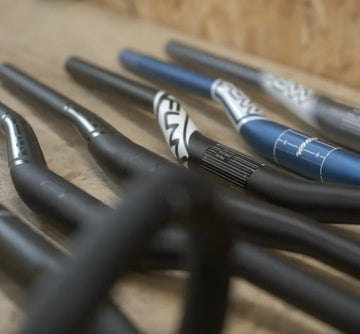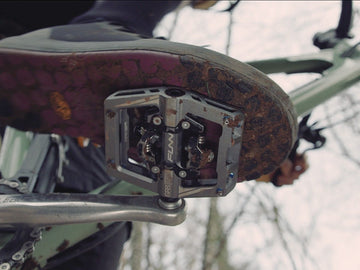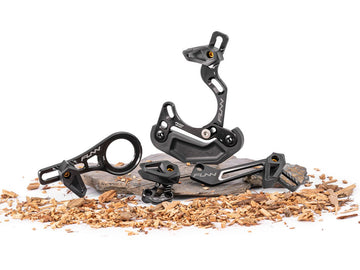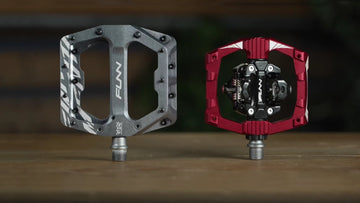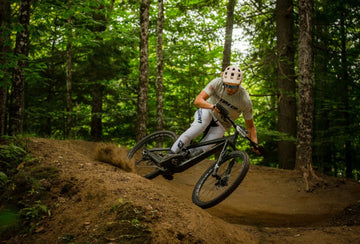This Episode we walk through with you on how to choose the right handlebar for your bike and navigate the various terminology and specification to find the right fit for your ride. We will also guide you through the proper way to shorten the handlebar to your preferred width.
When it comes to mountain biking, your handlebars are a crucial component that can significantly impact your riding experience. Whether you’re a seasoned rider or just starting out, selecting the right handlebar, setting it up correctly, and having the right tools on hand is essential. In this comprehensive guide, we’ll walk you through the process of choosing the right handlebars for your mountain bike.
Choosing the Right Handlebar for your stem
The first step in optimizing your mountain biking experience is selecting the right handlebar. Handlebars come in various shapes, materials, and widths, and your choice should align with your riding style and preferences. Here are some key factors to consider:
Bar Bore Dimension
Selecting the right mountain bike handlebar begins with ensuring it’s compatible with your stem. Stems are designed to accommodate handlebars with either a 31.8 mm or 35 mm bore dimension. While some riders lean towards the 35 mm bore for the added stiffness it brings, especially when navigating rugged terrains, others might favor the 31.8 mm variant, valuing the touch of added comfort it delivers.
For those considering Funn handlebars, determining the bar bore is straightforward. Simply look at the label placed at the center or the grip section of the handlebar. This ensures you’re always pairing the right handlebar with your stem, optimizing both fit and performance.

Choose Handlebar Material
Aluminum: Aluminum handlebars are lightweight and affordable, making them a popular choice among riders. They provide a good balance between durability and cost. Within this category, 6-series and 7-series alloys stand out.- 6-series Alloys contain magnesium and silicon, which endow them with versatility and corrosion resistance. Our Full on and Upturn handlebars are a testament to this alloy’s benefits. It represents a reliable choice, striking a balance between durability, comfort, and affordability.
- 7-series Alloys, primarily alloyed with zinc, offer greater strength and stiffness, which translates into more precise handling. Our Kingpin handlebar embodies these advantages. Tailored for performance-seekers, 7-series products like the Kingpin are often stiffer and lighter, though they might come at a higher cost and may be less corrosion-resistant.
Carbon Fiber: Carbon fiber handlebars, like our Black Ace, are exceptionally lightweight and excel in shock absorption. Tailored for riders who put a premium on weight savings and comfort, products such as Black Ace exemplify the best in carbon fiber craftsmanship. However, this superior performance and comfort come at a higher price point.
Choose handlebar dimensions
Handlebar Shape
Flat Handlebars: These handlebars maintain a straight and flat profile. They naturally place the rider in a forward-leaning position, optimizing for power and control. This aggressive riding posture is particularly suitable for cross-country (XC) pursuits where speed, efficiency, and control are paramount. Trail riders also often prefer flat bars for their direct terrain feedback and nimble handling experience. An example from our product range is the Flame On handlebar.
Riser Handlebars: With a gentle upward curve, riser handlebars elevate the rider’s hand position. This results in a slightly rearward-leaning posture, promoting a more relaxed and upright stance. Such a position offers better visibility and control in technical terrains, making these handlebars a preferred choice for downhill enthusiasts. All-mountain riders, encountering a mix of terrains, often opt for riser bars due to their comfortable ergonomics and versatility. From our collection, the Black Ace, Full On, Kingpin, and Upturn handlebars exemplify the benefits of the riser design.

Handlebar Width
The width of your handlebar plays a crucial role in dictating your bike’s performance and your comfort on the trail. Wider bars, often preferred by downhill and aggressive trail riders, extend the leverage, offering enhanced stability and control especially when navigating rough terrains. Their extended width aids in more effortless steering and balance, allowing riders to tackle challenging sections with confidence.
On the other hand, narrower bars are more aerodynamic, an attribute cross-country (XC) riders might favor for speed and efficiency during races. Additionally, a slimmer width proves advantageous when navigating through tight trails or densely wooded areas, preventing snags or collisions with obstacles.
For those unsure about the optimal width or those whose riding style varies, many handlebars, including some in our range, are designed to be cut down to a desired width. This customization ensures a tailored fit for the rider’s needs, combining comfort with precise control.
Handlebar Rise
The rise of the handlebar is another pivotal aspect to consider when choosing the perfect fit for your bike. Essentially, handlebar rise refers to the height difference between the center of the bar, where it attaches to the stem, and the center of the 22.2mm bar end.
Opting for a lower rise positions the rider’s weight closer to the front wheel, offering more direct steering feedback and a more aggressive posture – ideal for racers or those craving precision on descents. Conversely, a handlebar with a higher rise shifts the rider’s weight backward, promoting a more upright and relaxed riding stance, which can be beneficial for comfort and when navigating varied terrains. It’s essential to note that handlebar rise is largely a matter of personal preference, influenced by your riding style, bike geometry, and even trail conditions.

Upsweep and Backsweep
When selecting a handlebar, it’s not just the width or rise that plays a role in your riding comfort and control, but also the angles of upsweep and backsweep. These angles influence your hand positioning and, consequently, your overall posture on the bike.
Upsweep: Referring to the vertical angle at which the ends of the handlebar rise, upsweep ensures that your wrists remain in a more neutral and ergonomically sound position. Typically ranging between 4° to 6°, the right upsweep angle can prevent wrist strain, particularly during extended rides.
Backsweep: This is the horizontal angle at which the handlebar turns back towards the rider. A backsweep angle adjusts your hand position to be more in line with your arm’s natural alignment, thus offering enhanced comfort. Commonly found angles range between 5° to 9°, although the ideal angle can vary based on personal preference and riding style.
Choosing the proper upsweep and backsweep of your handlebars can significantly improve your comfort and fatigue levels. As always, personal preference plays a pivotal role, and it’s essential to test different configurations to find what aligns best with your anatomy and riding habits.

Conclusion
Navigating the nuances of mountain bike handlebars can initially seem overwhelming, but armed with the right knowledge, the journey becomes a rewarding exploration of precision and personal preference. Whether you’re weighing the merits of materials, dissecting dimensions, or analyzing angles, remember that the ultimate goal is to find the perfect union of comfort, control, and performance tailored to your unique riding style. The next time you hit the trails, you’ll do so with a handlebar that truly feels like an extension of yourself, amplifying every adventure. So, gear up, ride on, and savor the enhanced connection between you, your bike, and the great outdoors.


